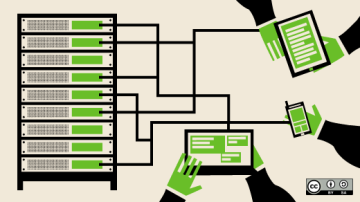I shared some important first steps to help manage your personal Linux server in a previous article. I briefly mentioned monitoring network connections for listening ports, and I want to expand on this by using the netstat command for Linux systems.
Service monitoring and port scanning are standard industry practices. There's very good software like Prometheus to help automate the process, and SELinux to help contextualize and protect system access. However, I believe that understanding how your server connects to other networks and devices is key to establishing a baseline of what's normal for your server, which helps you recognize abnormalities that may suggest a bug or intrusion. As a beginner, I've discovered that the netstat command provides important insight into my server, both for monitoring and network troubleshooting.
Netstat and similar network monitoring tools, grouped together in the net-tools package, display information about active network connections. Because services running on open ports are often vulnerable to exploitation, practicing regular network monitoring can help you detect suspicious activity early.
Install netstat
Netstat is frequently pre-installed on Linux distributions. If netstat is not installed on your server, install it with your package manager. On a Debian-based system:
$ sudo apt-get install net-toolsFor Fedora-based systems:
$ dnf install net-toolsUse netstat
On its own, the netstat command displays all established connections. You can use the netstat options above to specify the intended output further. For example, to show all listening and non-listening connections, use the --all (-a for short) option. This returns a lot of results, so in this example I pipe the output to head to display just the first 15 lines of output:
$ netstat --all | head -n 15
Active Internet connections (servers and established)
Proto Recv-Q Send-Q Local Address Foreign Address State
tcp 0 0 *:27036 *:* LISTEN
tcp 0 0 localhost:27060 *:* LISTEN
tcp 0 0 *:16001 *:* LISTEN
tcp 0 0 localhost:6463 *:* LISTEN
tcp 0 0 *:ssh *:* LISTEN
tcp 0 0 localhost:57343 *:* LISTEN
tcp 0 0 *:ipp *:* LISTEN
tcp 0 0 *:4713 *:* LISTEN
tcp 0 0 10.0.1.222:48388 syd15s17-in-f5.1e:https ESTABLISHED
tcp 0 0 10.0.1.222:48194 ec2-35-86-38-2.us:https ESTABLISHED
tcp 0 0 10.0.1.222:56075 103-10-125-164.va:27024 ESTABLISHED
tcp 0 0 10.0.1.222:46680 syd15s20-in-f10.1:https ESTABLISHED
tcp 0 0 10.0.1.222:52730 syd09s23-in-f3.1e:https ESTABLISHEDTo show only TCP ports, use the --all and --tcp options, or -at for short:
$ netstat -at | head -n 5
Active Internet connections (servers and established)
Proto Recv-Q Send-Q Local Address Foreign Address State
tcp 0 0 *:27036 *:* LISTEN
tcp 0 0 localhost:27060 *:* LISTEN
tcp 0 0 *:16001 *:* LISTENTo show only UDP ports, use the --all and --udp options, or -au for short:
$ netstat -au | head -n 5
Active Internet connections (servers and established)
Proto Recv-Q Send-Q Local Address Foreign Address State
udp 0 0 *:27036 *:*
udp 0 0 10.0.1.222:44741 224.0.0.56:46164 ESTABLISHED
udp 0 0 *:bootpc The options for netstat are often intuitive. For example, to show all listening TCP and UDP ports with process ID (PID) and numerical address:
$ sudo netstat --tcp --udp --listening --programs --numeric
Active Internet connections (only servers)
Proto Recv-Q Send-Q Local Address Foreign Addr State PID/Program name
tcp 0 0 0.0.0.0:111 0.0.0.0:* LISTEN 1/systemd
tcp 0 0 192.168.122.1:53 0.0.0.0:* LISTEN 2500/dnsmasq
tcp 0 0 0.0.0.0:22 0.0.0.0:* LISTEN 1726/sshd
tcp 0 0 127.0.0.1:631 0.0.0.0:* LISTEN 1721/cupsd
tcp 0 0 127.0.0.1:6010 0.0.0.0:* LISTEN 4023/sshd: tux@
tcp6 0 0 :::111 :::* LISTEN 1/systemd
tcp6 0 0 :::22 :::* LISTEN 1726/sshd
tcp6 0 0 ::1:631 :::* LISTEN 1721/cupsd
tcp6 0 0 ::1:6010 :::* LISTEN 4023/sshd: tux@
udp 0 0 0.0.0.0:40514 0.0.0.0:* 1499/avahi-daemon:
udp 0 0 192.168.122.1:53 0.0.0.0:* 2500/dnsmasq
udp 0 0 0.0.0.0:67 0.0.0.0:* 2500/dnsmasq
udp 0 0 0.0.0.0:111 0.0.0.0:* 1/systemd
udp 0 0 0.0.0.0:5353 0.0.0.0:* 1499/avahi-daemon:
udp6 0 0 :::111 :::* 1/systemd
udp6 0 0 :::44235 :::* 1499/avahi-daemon:
udp6 0 0 :::5353 :::* 1499/avahi-daemon:The short version of this common combination is -tulpn.
To display information about a specific service, filter with grep:
$ sudo netstat -anlp | grep cups
tcp 0 0 127.0.0.1:631 0.0.0.0:* LISTEN 1721/cupsd tcp6 0 0 ::1:631 :::* LISTEN 1721/cupsd
unix 2 [ ACC ] STREAM LISTENING 27251 1/systemd /var/run/cups/cups.sock
unix 2 [ ] DGRAM 59530 1721/cupsd
unix 3 [ ] STREAM CONNECTED 55196 1721/cupsd /var/run/cups/cups.sock
Next steps
Once you've run the netstat command, you can take steps to secure your system by ensuring that only services that you actively use are listening on your network.
- Recognize commonly exploited ports and services. As a general rule, close the ports you're not actually using.
- Be on the lookout for uncommon port numbers, and learn to recognize legitimate ports in use on your system.
- Pay close attention to SELinux errors. Sometimes all you need to do is update contexts to match a legitimate change you've made to your system, but read the errors to make sure that SELinux isn't alerting you of suspicious or malicious activity.
If you find that a port is running a suspicious service, or you simply want to close a port that you no longer use, you can manually deny port access through firewall rules by following these steps:
If you're using firewall-cmd, run these commands:
$ sudo firewall-cmd –remove-port=<port number>/tcp
$ sudo firewall-cmd –runtime-to-permanentIf you're using UFW, run the following command:
$ sudo ufw deny <port number>Next, stop the service itself using systemctl:
$ systemctl stop <service>Learn netstat
Netstat is a useful tool to quickly collect information about your server's network connections. Regular network monitoring is important an important part of getting to know your system, and it helps you keep your system safe. To incorporate this step into your administrative routine, you can use network monitoring tools like netstat or ss, as well as open source port scanners such as Nmap or sniffers like Wireshark, which allow for scheduled tasks.
As servers house larger amounts of personal data, it's increasingly important to ensure the security of personal servers. By understanding how your server connects to the Internet, you can decrease your machine's vulnerability, while still benefiting from the growing connectivity of the digital age.










Comments are closed.